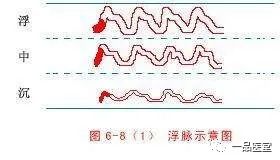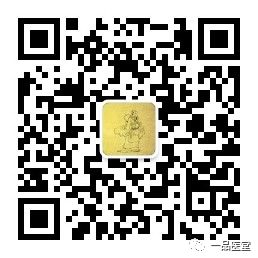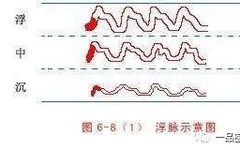
Floating Pulse (fú mài) characteristics: easily felt with light pressure, slightly diminished with heavy pressure but not absent, more pronounced when lifted, and less pronounced when pressed. The floating pulse can be understood as a pulse located superficially, described as “floating like wood on water” or “a gentle breeze lifting the feathers on a bird’s back.” Its pulse characteristics indicate that the pulse wave is felt in the superficial layer beneath the skin. Therefore, when lightly pressing on the radial artery, the pulse can be felt. The key to identifying the floating pulse is “less pronounced when pressed, more pronounced when lifted.” During pulse diagnosis, one first feels the floating pulse by lightly placing the fingers on the skin at the wrist, then applies more pressure to feel a significant reduction in pulse strength. When pressure is released, the pulse strength slightly increases again, resembling the image of wood floating on water. If pressure is applied, the wood sinks; if pressure is gradually reduced, the wood becomes more visible, illustrating the floating pulse’s characteristic of being more pronounced when lifted and less pronounced when pressed. Clinical significance: Generally indicates exterior syndromes (exterior pathogenic diseases: such as colds, also representing warm diseases in the protective level). The floating pulse is located outward and belongs to the Yang pulses. The Huangdi Neijing refers to it as “毛脉” (máo mài). Lean individuals with thin muscles may exhibit a floating pulse, and during summer and autumn, a floating pulse is a normal variation. The presence of a floating pulse in exterior syndromes indicates the expulsion of pathogens. When external pathogens invade the body, the righteous Qi resists the pathogens externally, causing the Qi and blood to move towards the superficial layer, resulting in a floating pulse. When the pathogenic influence is strong and the righteous Qi is not deficient, the pulse is floating and strong (exterior excess); when the pathogenic influence is strong and the righteous Qi is weak, the pulse is floating and weak (exterior deficiency).Diseases associated with floating pulse in various locations: The floating pulse indicates Yang exterior diseases. A floating pulse at the cun (寸) position may indicate headaches or dizziness due to wind, or the presence of phlegm and wind in the chest. A floating pulse at the guan (关) position indicates a deficiency of earth and an excess of wood, while a floating pulse at the chi (尺) position may indicate urinary issues. The pulse is diagnosed in three positions: cun, guan, and chi, reflecting the pathological changes in the upper, middle, and lower jiao of the body. A floating pulse at the cun position often indicates upper jiao issues, such as headaches or dizziness, or the accumulation of wind and phlegm in the chest; at the guan position, it often indicates an excess of liver Qi and a deficiency of spleen Qi; at the chi position, it may indicate urinary difficulties or constipation.Comparison with similar pulses:Floating Pulse (fú mài) is characterized by being easily felt and light. Empty Pulse (kōu mài) is large and hollow, like pressing on a scallion tube. Leather Pulse (gé mài) feels like pressing on a drum skin, while Scattered Pulse (sàn mài) resembles floating willow fluff with no fixed trace. (1)Empty Pulse (kōu mài) (Yang within Yin): Characteristics: large and hollow when lightly pressed, like pressing on a scallion tube. The empty pulse is characterized by being large and soft, with a hollow center when pressed, indicating a state of reduced blood volume within the pulse vessel, insufficient filling, and low tension.Clinical significance: Commonly seen in cases of sudden significant blood loss or Yin deficiency. Chronic blood loss or prolonged menstrual irregularities may not present with an empty pulse, which is an important distinction to understand.Diseases associated with empty pulse in various locations: A floating empty pulse at the cun position may indicate blood stasis in the chest, while at the guan position, it may indicate gastrointestinal abscesses. At the chi position, it may indicate lower gastrointestinal bleeding, such as hematuria or dysentery. Hematuria refers to painful urination with blood, while dysentery refers to excessive vaginal bleeding outside of the menstrual period. Due to conditions like excessive bleeding or sudden blood loss, the blood volume decreases rapidly, leading to a hollow pulse, as the Yin blood cannot support the Yang Qi, causing the pulse to appear large and floating. If blood loss and Yin deficiency persist, blood vessels may constrict, or through blood transfusions and fluid replacement, Yin fluids may be replenished, increasing blood volume, thus the empty pulse may no longer be present.(2) Leather Pulse (gé mài) (Yin): Characteristics: floating and broad, hollow on the inside but firm on the outside, like pressing on a drum skin. The leather pulse is characterized by a large and firm pulse wave felt superficially, but with a weak response when pressed, giving a feeling of hollowness, similar to pressing on a drum skin.
Although both the leather pulse and empty pulse exhibit a feeling of hollowness when pressed, the leather pulse is floating and taut, while the empty pulse resembles pressing on a scallion tube.
Clinical significance: Commonly seen in cases of postpartum complications, blood loss, or prolonged leakage of essence. In women, the leather pulse is primarily associated with postpartum complications and excessive bleeding, while in men, it is mainly associated with blood deficiency and nocturnal emissions. The depletion of essence and blood leads to insufficient filling of the pulse vessels, causing the righteous Qi to be unstable, resulting in a large and floating pulse that feels taut on the outside and hollow on the inside, resembling a tightly stretched drum skin, which produces the leather pulse.(3) Scattered Pulse (sàn mài) (Yin): Characteristics: floating and scattered, with an irregular rhythm, sometimes fast and sometimes slow, but without clear pauses, or the pulse strength varies inconsistently. Therefore, the scattered pulse is a floating pulse without a root, described as “scattered like willow fluff with no fixed trace.”Clinical significance: Commonly seen in cases of dispersed vital Qi, weak organ Qi, especially in critical conditions where the heart and kidney Qi are about to fail. The body’s Qi and blood are weak, essence is depleted, Yin cannot contain Yang, and Yang Qi disperses, leading to a pulse that cannot be contained, resulting in a large and floating pulse without a root, with an irregular rhythm.Diseases associated with scattered pulse in various locations: A scattered pulse at the left cun position may indicate palpitations, while at the right cun position, it may indicate sweating. A scattered pulse at the left guan position may indicate fluid retention (edema), while at the right guan position, it may indicate swelling in the ankle area. A scattered pulse at both chi positions may indicate impending organ failure and critical conditions.Summary of distinctions: Floating pulse, empty pulse, leather pulse, and scattered pulse: all four pulse types are located superficially and can be easily felt. The difference is that the floating pulse is more pronounced when lifted and less pronounced when pressed but not absent, with a medium size. The empty pulse is large and weak, with a hollow center, like pressing on a scallion tube; the leather pulse is floating and taut, with a large and firm wave, like pressing on a drum skin; the scattered pulse is floating and rootless, with an irregular rhythm and inconsistent strength, but without pauses.

Identifying the pathogenesis, regardless of the disease name.
Analysis of Wumei Pill Formula

